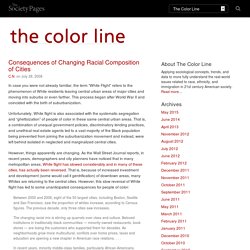

Report griswold norris. Consequences of Changing Racial Composition of Cities - The Color Line. In case you were not already familiar, the term “White Flight” refers to the phenomenon of White residents leaving central urban areas of major cities and moving into suburbs or even farther.

This process began after World War II and coincided with the birth of suburbanization. Unfortunately, White flight is also associated with the systematic segregation and “ghettoization” of people of color in these same central urban areas. That is, a combination of unequal government policies, discriminatory lending practices, and unethical real estate agents led to a vast majority of the Black population being prevented from joining the suburbanization movement and instead, were left behind isolated in neglected and marginalized central cities. However, things apparently are changing. The 9 Most Segregated Cities In America. In Detroit, more people rent homes than own them. TODAY'S TOP STORIESNSC shakeup has K.T.

McFarland leaving White House | 0:36 K.T. McFarland is set to leave her position as deputy national security adviser. USA TODAY 1 of 8 TODAY'S TOP STORIESFord to offer gas-electric hybrid police pursuit cars | 1:32 The next time the cops chase you down for speeding, they could be driving a fuel-efficient gas-electric hybrid. 2 of 8 TODAY'S TOP STORIESWatch: Time-lapse of Joe Louis Arena finale | 0:38 Enjoy a time-lapse of the final game at Joe Louis Arena, from the pregame to the postgame celebration. 3 of 8 TODAY'S TOP STORIESWatch: Putting a bow on amazing day at the Joe | 4:30 Free Press sports writers Helene St. 4 of 8 TODAY'S TOP STORIES3 officers assaulted at Tennessee prison | 0:30.
The 12th Street riot - Jul 23, 1967. In the early morning hours of July 23, 1967, one of the worst riots in U.S. history breaks out on 12th Street in the heart of Detroit’s predominantly African-American inner city.

By the time it was quelled four days later by 7,000 National Guard and U.S. Army troops, 43 people were dead, 342 injured, and nearly 1,400 buildings had been burned. By the summer of 1967, the predominantly African-American neighborhood of Virginia Park was ready to explode. Some 60,000 poor people were crammed into the neighborhood’s 460 acres, living in squalor in divided and sub-divided apartments. The Detroit Police Department, which had only about 50 African Americans at the time, was viewed as a white occupying army.
At night, 12th Street was a center of Detroit inner-city nightlife, both legal and illegal. That night, the establishment was hosting a party for several veterans, including two servicemen recently returned from Vietnam, and the bar’s patrons were reluctant to leave. Detroit Mayor Jerome P. 2Haines. What are the sources of revenue for local governments? Intergovernmental Transfers Of the 36 percent of local government general revenue that were transfers from other levels of government, 32 percent came from state governments (including indirect federal funds), and 4 percent came directly from the federal government.

Local governments include county governments, municipalities, townships, special districts (such as water and sewage authorities), and school districts. Aid to school districts account for more than half of all state government transfers to localities. Housing programs make up 40 percent of federal transfers to local governments. Own-Source Revenue Revenue from property taxes was $452 billion in 2014—30 percent of local government general revenue and the largest single source of tax revenue (figure 1). Changing Sources Since 1977, the share of local government revenue from nontax sources has remained fairly steady at 60 percent of general revenue.
Revenue Growth Compared with Economic Growth. Marilyn Salenger: ‘White flight’ and Detroit’s decline - The Washington Post. By Marilyn Salenger By Marilyn Salenger July 21, 2013 Marilyn Salenger is president of Strategic Communications Services and a former correspondent and news anchor for several CBS stations.

An almost palpable sadness has swept across the country at the news that the city of Detroit has filed for bankruptcy. While the possibility of this had been discussed, the reality of what was once the fourth-largest city in the United States sinking to such depths is disheartening, a moment people will remember for years to come. To understand that the decline and bankruptcy represent so much more than dollars and cents requires a step back to a time that many would prefer to forget but remains unforgettable. In the late 1960s,racial tensions engulfed parts of our country, at the cost of lost lives and abject destruction. It was the beginning of the ending we are now seeing for a city that once stood tall with head held high. Opinions Orlando Shooting Updates post_newsletter348 follow-orlando true after3th.